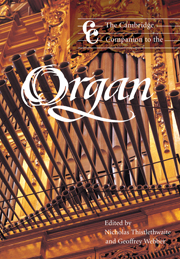Book contents
- Frontmatter
- Part I The instrument
- Part II The player
- Part III Selected repertoires
- 10 Italian organ music to Frescobaldi
- 11 Iberian organ music before 1700
- 12 The French classical organ school
- 13 English organ music to c1700
- 14 Catholic Germany and Austria 1648–c1800
- 15 The north German organ school
- 16 The organ music of J. S. Bach
- 17 German organ music after 1800
- 18 French and Belgian organ music after 1800
- 19 British organ music after 1800
- 20 North American organ music after 1800
- Appendix: The modes (toni) and their attributes according to Zarlino
- Notes
- Bibliography
- Index
13 - English organ music to c1700
from Part III - Selected repertoires
Published online by Cambridge University Press: 28 September 2011
- Frontmatter
- Part I The instrument
- Part II The player
- Part III Selected repertoires
- 10 Italian organ music to Frescobaldi
- 11 Iberian organ music before 1700
- 12 The French classical organ school
- 13 English organ music to c1700
- 14 Catholic Germany and Austria 1648–c1800
- 15 The north German organ school
- 16 The organ music of J. S. Bach
- 17 German organ music after 1800
- 18 French and Belgian organ music after 1800
- 19 British organ music after 1800
- 20 North American organ music after 1800
- Appendix: The modes (toni) and their attributes according to Zarlino
- Notes
- Bibliography
- Index
Summary
Pre-Reformation organ music
No English organ music from before 1500 has survived. There are a few earlier instances that are sometimes cited, but they can all be discounted for one reason or another. The pieces in the Robertsbridge Codex, which date from about 1320, are probably of French or Italian origin, despite the fact that they have been preserved in England (Caldwell 1973: 1–9). The Buxheimer Orgelbuch, compiled in Germany about 1470, includes transcriptions of some sacred and secular vocal pieces by John Dunstable, but these are only intabulations by a German organist and not original keyboard settings by Dunstable. One other piece sometimes thought to be an early example of English organ music is an anonymous Felix namque copied about 1420 (Dart 1954: 201; Caldwell 1973: 14), but this is more likely to be a simple piece of vocal discant.
It is not until the first half of the sixteenth century that a large corpus of genuine English organ music is to be found. In this pre-Reformation period in England, most of the organ music is strictly liturgical in function, being designed for performance at specific points during the Mass and Office. The pre-Reformation period can be said to extend up to the accession of Elizabeth I in 1558, for, despite the introduction of the first Book of Common Prayer in 1549, the Latin rite was fully restored in the reign of Mary (1553–8). The main two composers around the middle of the century were John Redford (c1486–1547) and Thomas Preston (active in the 1540s and 50s), who were followed by Thomas Tallis (c1505–85) and William Blitheman (died 1591), most of whose liturgical organ music probably dates from the reign of Mary.
- Type
- Chapter
- Information
- The Cambridge Companion to the Organ , pp. 190 - 203Publisher: Cambridge University PressPrint publication year: 1999



